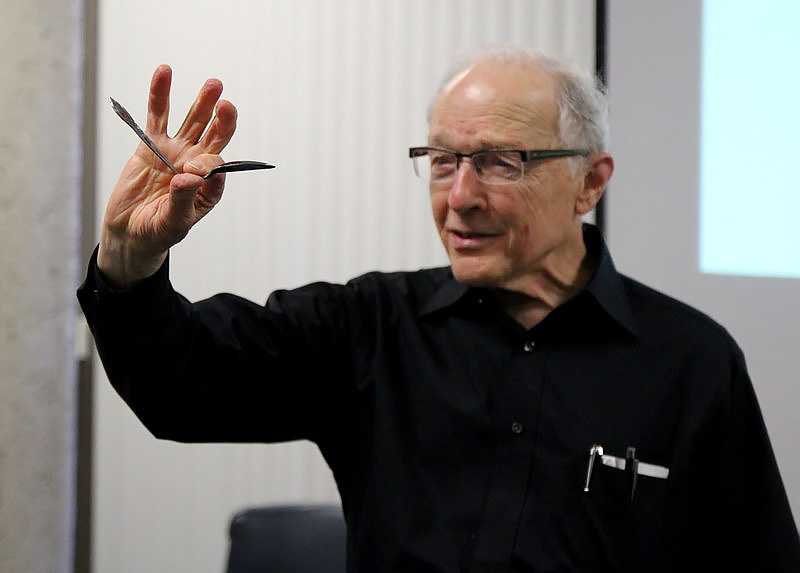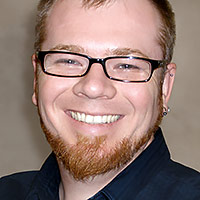
Ray Hyman demonstrates “psychic” spoon bending in 2012. (Image by Susan Gerbic [CC BY-SA 3.0], via Wikimedia Commons.)
In a post last year called “The Forgetfulness of Skepticism,” I discussed one of the difficulties that skeptics face as a result of our small community and very broad subject area:
Generations of skeptics have devoted themselves to understanding paranormal and pseudoscientific claims, beliefs, and impostures. But even with those efforts, the fringe has remained radically under-examinded. Because this realm is so vast while the scholars and activists interested in exploring it are so few, our work has often had something of a scrambling quality. In our rush, skeptics have tended to neglect, or at least to set aside for some future time, some of the improvements of better-established fields.
Many other fields benefit from the attention of historical, theoretical, and philosophical spin-off disciplines. Consider, for example, art history, English literature, medical ethics, or philosophy of science. Skeptics, by contrast, are caught in a kind of perpetual startup culture. With so many urgent triage priorities, the considerable task of recording, maintaining, and passing down legacy knowledge becomes a “nice to have”—a luxury for further down the road. As a result, we tend not to remember very well.
Skepticalisms
Hyman’s Maxim:
“Do not try to explain something until you are sure there is something to be explained.”
Thankfully, a poor memory is not quite the same as amnesia. We do our best to make note of our roots and (ideally) learn from them. There are a number of people who have taken a specific interest in skeptical history over the years, including Michael Shermer, Kendrick Frazier, Tim Farley, and yours truly.
Skeptics do remember some things better than others. For example, we preserve and pass along sayings of the type that investigator Joe Nickell has dubbed “skepticalisms”—useful bits of aphoristic wisdom relevant to our area of study—though we may not always have a clear idea of the history of those sayings or of the ideas they promote. It can be an illuminating exercise to trace earlier uses of those sayings, as I did for “Extraordinary claims demand extraordinary evidence” and as INSIGHT blogger Tim Farley has done for “Keep an open mind, but not so open that your brains fall out.”
Today I’d like to consider another skeptical saying—not to trace the history of the phrase as an evolving meme, but to consider its value as a practical tool for use in examining paranormal claims. It’s a saying that psychologist and founding CSICOP (CSI) member James Alcock called “Hyman’s Categorical Imperative,” after a point articulated frequently by fellow psychologist and skeptical pioneer Ray Hyman: “Do not try to explain something until you are sure there is something to be explained.”1
Today, this saying is often called “Hyman’s Maxim.” And it’s a doozy.
“Explain That, Skeptic!”
I’ve argued that “most of what we actually do as skeptical investigators is…to ask (and sometimes to answer) this question: What really happened?” This is perhaps the central task that skeptics are challenged to perform, by media, critics, and our own friends and loved ones: Here is story about a miracle. Explain that, skeptic!
Skeptics often point out this challenge misplaces the burden of proof. That’s true. It does. But is that the end of the story? I’ve suggested that scientific skepticism should not over-rely upon burden of proof arguments, because ultimately “the goal of the skeptical project is not to stonewall weird ideas, but to find out what’s true.” That’s why I’m here, anyway. I’m interested in helping to find stuff out.
“If you start with tainted data, the best critical thinking will be useless.”
Nonetheless, there are serious practical pitfalls in accepting the challenge to “explain that, skeptic!” When we take on the burden of explanation, we also take on the risk of getting it wrong—the risk of misinforming the public, of becoming bullshit peddlers ourselves. An example I use to illustrate this danger is the cottage industry of proposed “natural” explanations for miraculous occurrences described in the Bible and other ancient stories. Oceans of speculative ink have been spilled “explaining” the parting of the Red Sea, the Resurrection of Jesus, the Sun standing still for Joshua, and other such miracle tales. Of course, many of these “natural” explanations are pseudoscientific rubbish, but that’s really beside the point: all such explanations are superfluous if these events never happened at all, and premature until we can confirm that they did.
An active skeptic since the 1950s, Ray Hyman has long warned against the danger of premature or speculative “explanation”—a danger which goes to the heart of the skeptical project. As he emphasized again in an email,
I have always believed that many skeptics seriously err when they attack paranormal claims. They usually accept the reliability of the observations on which the paranormal claim is based. The typical ploy of these skeptics is to contrive alternative explanations for the observations or phenomena under question. … Sometimes they were correct. Many times they were way off base—especially when trying to account for events…which never happened! … If you start with tainted data, the best critical thinking will be useless.2 [Emphasis added.]
The Origin of “Hyman’s Maxim”
It’s sometimes been argued, as Hyman himself has done,3 that then-popular “psychic” performer Uri Geller “gets credit” for provoking scattered skeptical activists to come together in the 1970s as a newly-organized movement or community. Geller’s early career also provides an excellent illustration of the pitfall that “Hyman’s Maxim” is intended to warn against. Hyman described this anecdote to me to me as “a clear example of what I have in mind.”
Here’s how Hyman told the story in the pages of a now-classic 1998 Skeptic magazine interview by Michael Shermer (recently released online in the Skeptics Society’s free eSkeptic newsletter):
In December, 1972…I got a phone call from a Colonel…Austin Kibler, who worked in what was then called the Advanced Research Projects Agency of the Department of Defense, set up by President Kennedy. It was sort of the Buck Rogers part of the defense department dealing with futuristic technologies. Kibler…called and said…“This is very important. There is this psychic down there. I know what you’re thinking, but this guy is not like any other psychic you have ever seen. He can do anything most psychics can do, but he can also bend metal with his mind.”
I said something incredulous, so Kibler responded, “I don’t necessarily believe, but I’ve watched him myself and let me tell you what he did. In a room of scientists…he asked to borrow a ring. He said ‘Don’t let me touch it.’ He didn’t touch the ring, which was placed in the middle of a table. He concentrated on it and the ring stood on end, split, and shaped itself into the letter S.” When I inquired more about it, it became clear that Kibler had not actually witnessed this himself, but had heard about it, and this was another lesson to me about what actually happens and what gets reported.
…
So he begged me to go and the next day I found myself in the presence of Uri Geller. … So I said, “did anyone actually see him bending this brass ring without touching it?”
It turns out that none of them had actually witnessed this great feat of mental metal bending. This whole story about how the brass ring got bent was from Geller himself! Geller told them he did this, and they just believed [him]. It was amazing. In fact, half the things I had heard about Geller, came from Geller himself, not from someone witnessing them.4
Here we have a cluster of conceptual concerns central to skeptical investigation of paranormal claims (and indeed relevant to all investigation of any kind): the difficulty of establishing basic facts, the foolhardiness of premature speculation, the malleability of memory—and of course, the seductive, dangerous power of story. “Like the phenomena behind many occult claims, the story grew more and more inexplicable with each retelling,” Hyman reflected. “By the time Colonel Kibler told it to me, it had become quite impressive, indeed.”5
I’ve written before about the jarring, eye-opening experience of finding modern-sounding concepts, jargon, and arguments in the skeptical writing of previous generations. Hyman’s Maxim captures fundamental truths about paranormal beliefs and investigation, so it ought not to surprise us to discover related discussions from long before Hyman stepped upon the stage. In an upcoming post, we’ll look into that prehistory of one of skepticism’s most valuable insights.
References
- James Alcock. “Afterword: An Analysis of Psychic Sleuths’ Claims. In Joe Nickell, Psychic Sleuths. (Buffalo, New York: Prometheus Books, 1994.) p. 189
- Ray Hyman, email to Daniel Loxton. December 16, 2014
- Michael Shermer. “The Truth is Out There & Ray Hyman Wants to Find It.” Skeptic Vol.6, No.2 (1998). p. 93
- Ibid. pp. 93–94
- Ray Hyman, email to Daniel Loxton. December 16, 2014










